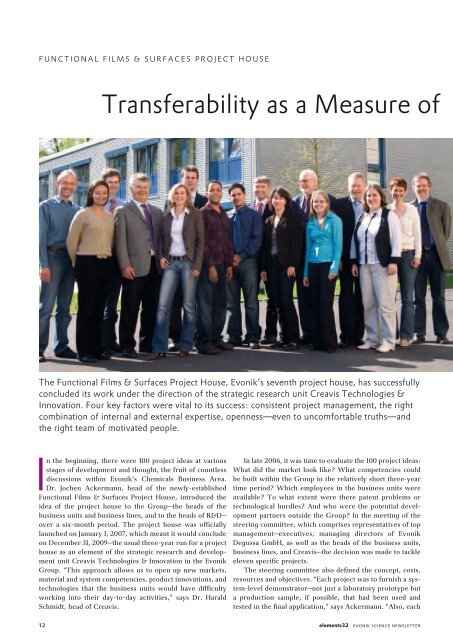Download - Evonik Industries
Download - Evonik Industries
Download - Evonik Industries
Create successful ePaper yourself
Turn your PDF publications into a flip-book with our unique Google optimized e-Paper software.
F U n c t i o n A l F i l M S & S U r F A c e S P r o J e c t H o U S e<br />
transferability as a Measure of<br />
the Functional Films & Surfaces Project House, evonik’s seventh project house, has successfully<br />
concluded its work under the direction of the strategic research unit creavis technologies &<br />
innovation. Four key factors were vital to its success: consistent project management, the right<br />
combination of internal and external expertise, openness—even to uncomfortable truths—and<br />
the right team of motivated people.<br />
In the beginning, there were 100 project ideas at various<br />
stages of development and thought, the fruit of countless<br />
discussions within <strong>Evonik</strong>‘s Chemicals Business Area.<br />
Dr. Jochen Ackermann, head of the newly-established<br />
Func tional Films & Surfaces Project House, introduced the<br />
idea of the project house to the Group—the heads of the<br />
business units and business lines, and to the heads of R&D—<br />
over a six-month period. The project house was officially<br />
launched on January 1, 2007, which meant it would con clude<br />
on De cem ber 31, 2009—the usual three-year run for a project<br />
house as an element of the strategic research and development<br />
unit Creavis Technologies & Innovation in the <strong>Evonik</strong><br />
Group. “This approach allows us to open up new markets,<br />
material and system competencies, product innovations, and<br />
technol ogies that the business units would have difficulty<br />
working into their day-to-day activities,” says Dr. Harald<br />
Schmidt, head of Creavis.<br />
In late 2006, it was time to evaluate the 100 project ideas:<br />
What did the market look like? What competencies could<br />
be built within the Group in the relatively short three-year<br />
time period? Which employees in the business units were<br />
available? To what extent were there patent problems or<br />
technological hurdles? And who were the potential development<br />
partners outside the Group? In the meeting of the<br />
steering committee, which comprises representatives of top<br />
management—executives, managing directors of <strong>Evonik</strong><br />
Degussa GmbH, as well as the heads of the business units,<br />
business lines, and Creavis—the decision was made to tackle<br />
eleven specific projects.<br />
The steering committee also defined the concept, costs,<br />
resources and objectives. “Each project was to furnish a system-level<br />
demonstrator—not just a laboratory prototype but<br />
a production sample, if possible, that had been used and<br />
test ed in the final application,” says Ackermann. “Also, each<br />
12 elements32 evonik science newsletter

















